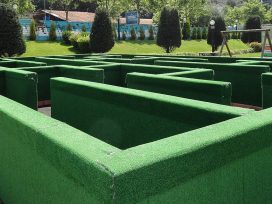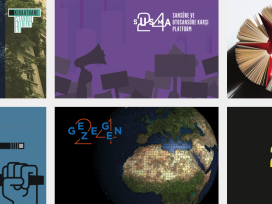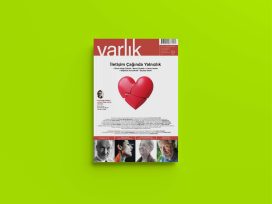The issue of European-Turkish relations, and of Turkey’s membership in the EU, can be discussed within the context of post-Cold War globalization. Turkey’s place in Europe, and Europe’s place in Turkey, pertains to the broader question of cultural interactions around the world today. Moreover, the intertwined histories of Europe and Turkey, which contain numerous examples of such interactions, including the construction of the idea of the modern residential neighbourhood, may provide us with some insights into issues of Turkish and European national and cultural identities.
I
The significance of a new theory of intertwinedness will become clearer after contrasting two recently produced world maps that represent two different conceptions of the same world after the Cold War: The first map illustrates the theory of the “clash of civilizations”, which became a catchphrase in conservative circles, especially in the United States, after 9/11. The term was first suggested by Bernard Lewis in 1990, who claimed that there is a “deep essential difference” between Islam and the “West”; the theory was then elaborated by Samuel Huntington in 1996. Huntington’s premise was explicit in his initial words: “We know who we are only when we know who we are not, and often when we know whom we are against.” According to Huntington, the main political tensions in the post-Cold War era are now cultural and the world is separated into nine civilizations that are mostly, if not exclusively, based on religious categories. Huntington concluded by asserting that, “the world is [still] divided between the West [as the dominant civilization] and “the non-Western many.” Unsurprisingly, when Huntington was asked to comment on Turkey’s membership in the European Union, he stated that Europe and Turkey barely belong to the same civilization.His opinion on European-Turkish relations reflected transparently his position on post-Cold War globalization. In his mind, the borders of the nine civilizations are rigid and timeless, allowing little opportunity for fluid and flexible interface. In this respect, his map falls well short in dealing with the history and the potential future of cultural interactions – as if a “pure Western” and any of these nine “pure-non-Western” civilizations ever existed, or the “pure West” were a category that could and should be preserved.
The second map, by the architect Rem Koolhaas and the think-tank AMO, is entitled “Regime of the ¥€$”: in it, a mirror image of the world map aligns Asia, Europe, and the US with the yen, the euro, and the dollar. As flippant as the map may seem, it provides a fruitful gesture absent in Huntington’s, namely an acknowledgement of the fluidity of borders around the world. Unsurprisingly, when Koolhaas was asked to comment on Turkey’s membership in the European Union, he proposed that EU officials forget “Europe” and let the Union expand as much as it can. However, one should not read Koolhaas’ map for more than what it is, namely a big “Yes” (albeit ironic) to global capital and its three main protagonists. What the map does not say, though implies, is the big “No” uttered by individuals subjected to global poverty, a “No” not to unification, but to economic domination. Koolhaas’ map parodies the way in which the unification of the “West” and its “other” is promoted on the condition that the latter accords with the rules of Western capitalism. Hospitality towards the “other” still requires that the “other” be assimilated into the “host”. As such, the map is a critique of the neo-liberal ignorance that designates capitalism as the bearer of perpetual peace.
Without wanting to disregard specific conditions, it is plausible to suggest that the world views represented in the two maps resonate in the discussions about European-Turkish relations. The opposition between the theory of radical difference between world civilizations and that of global unity based on commercial interaction is not dissimilar to the debate on Turkey’s EU accession, which oscillates between the alleged difference and the alleged uniformity of Turkey and Europe.
Before jumping to conclusions about cultural interaction present and future, it is necessary to note the disturbing degree to which scholarship is resistant to writing the history of such interactions, and the amount of methodological revision such an undertaking would necessitate. What if, when trying to understand the history of a cultural practice in a specific country, we always did so on the basis of its intertwined relations with those of other countries? This would require, above all, defying a number of current and long-standing habits in history writing and cultural studies. Today, most scholarship in these fields takes the nation-state as a given category. Scholars specialize in “Turkish”, “German”, “American”, or “Indian” history; studies are placed under general but separate categories, such as “Islamic culture”, “European architecture”, “non-Western building”, and so forth. However, histories and cultural accounts written from the perspective of particular nation-states no longer help us understand interactions that have taken place around the world. An historiographic approach able to account for intertwined histories would therefore require the expansion of current methodological boundaries, which, as they stand, perpetuate geographical limits that are either narrowly national or broad but rigid.
II
The emergence and dissemination of the idea of the modern residential neighbourhood as a physical urban entity is an example of such an intertwined history. While it is not possible to speak about a single conception of a residential neighbourhood in modernity, and although the traditional idea of a neighbourhood may seem anachronistic to modernity in the first place, since modern metropolitan living connotes anonymity rather than neighbourly association, there is nevertheless a large body of historical examples of residential neighbourhoods generated as a direct result of modernization. Comparing the development of the modern residential neighbourhood in the twentieth century, it becomes clear that its architectural conception, city planning, and administrative principles were constructed collectively during a series of translation processes between numerous countries. This was the case in Germany and Turkey during the first half of the twentieth century: industrialization in Germany and Westernization and nationalization in Republican Turkey brought corresponding forms of housing. This type of housing is usually referred to as Siedlung in German, and mahalle in Turkish (although mahalle connotes many other types of urban quarters). It was a pre-planned residential settlement composed of a large number of identical single houses or identical multi-family apartment blocks. The planners intended that a neighbourly community would be created as a result of residents pooling financial resources on a co-operative basis and sharing numerous social and cultural services, such as parks, green lawns, sports facilities, kindergartens, laundries, shopping arteries, and in some cases communal dining halls.
In Germany, the idea of the Siedlung developed as a reaction against housing shortages and the destitute living conditions of industrial workers in the Mietskasernen (rental barracks) of the big cities. The Mietskasernen – with their narrow courtyards, inadequate light and air, and unchecked expansion, remained the main target of criticism; they were accused of numerous offences, such as overcrowding, poor sanitation, and alienation from nature. As the artist Heinrich Zille famously said, “one can kill a man with a dwelling as easily as with a hammer”. The professional architectural debate was geared towards remedying what was perceived as the unnatural lifestyle of the industrial age, the lack of cohesive neighbourhoods, and the uncontrolled development of cities. Architects saw their task as being to reinsert a sense of community into the lives of modern citizens through the newly defined concept of the modern neighbourhood. In the eyes of its promoters, the Siedlung would not only be beneficial to public welfare by achieving affordable housing for the poor; it would also generate neighbourly feeling among its residents. Far from being oppressive, these new environments allowed their working and middle class residents to combine their financial resources and escape the destitute living conditions of the Mietskasernen.
The concept of the Siedlung was translated into the Turkish context via the interaction of numerous German architects with local architects and international students. The Kemalist government considered the Siedlung to be the appropriate model of housing for the newly-founded nation-state and, just one year after the foundation of the Turkish Republic, began inviting German architects and city planners to build Turkish neighbourhoods and cities from scratch. The architectural formula was applied in numerous cases, ranging from upper-middle class neighbourhoods for Ankara’s new bureaucrats to working class housing for the coalminers of Zonguldak; from the settlements built for the industrial workers of Sumerbank to villages built from scratch to settle the immigrants from the Balkans, who came to the country as a result of the population exchange with Greece, Romania, and Bulgaria.
With the rise of National Socialism, many German architects working on Siedlung projects in Germany moved to Turkey (in the reverse direction to that usually known about). Key figures of the German Siedlung experience in Berlin and Frankfurt, such as Bruno Taut, Martin Wagner, Margarete Schutte-Lihotzky, and Ernst Reuter, were among the professionals who emigrated to Turkey during this period. After their arrival, the principles of the German Siedlung were hybridized with the ideas of their Turkish colleagues, who had not only been closely following developments in Europe, but had also been constructing original discourses about “Turkish houses”. Turkish architects who had either been educated in Germany or had studied under the German immigrants in Turkey, such as Seyfi Arkan, Sedad Eldem, Kemal Ahmet Aru, also became the key actors in this story.
These modern residential neighbourhoods in Germany and Turkey shared numerous features. Their site planning and unit design strategies were based on similar architectural principles, namely the repetition of houses and multi-family blocks consisting of more or less identical dwelling units. In both countries, designs reflected the emergent industrial culture by standardizing building parts such as doors and windows, sanitary appliances, and sometimes even whole kitchens. The individual dwelling units were designed according to what the architects liked to call “rational”, “functional”, “economic”, and “efficient” architectural principles. Architects aspired to construct a built environment, a neighbourhood, for a cohesive community that shared numerous cultural and social facilities, including communal green areas and courtyards with children’s playgrounds. These courtyards were initially open to the general public, however as tendencies towards border building started to overrule tendencies towards sharing, they were fenced off and shut behind doors. The financial models of these neighbourhoods were also similar, allowing residents to combine their resources on a co-operative basis. In the most affordable cases, neighbourhoods were made possible by the financial and administrative help of local municipalities through tax cuts to the disadvantaged.
Ernst Reuter’s comparison between the Ottoman waqf system – donating the benefit of one¹s specific and durable property for the sake of the Muslim poor – and the social-democratic ideals of the European municipalities, exemplifies a cultural flow in the opposite direction to that commonly assumed. Reuter emigrated to Turkey in 1935, having been imprisoned in a concentration camp. He became the head of the first city-planning department in Turkey, where he remained until 1946 (when he was appointed the first mayor of West Berlin). While in Turkey, Reuter held long correspondences with Thomas Mann, in which the two envisioned a new postwar Germany. Reuter compared the financial commitment to public services contained in the waqf system with his own plans for the structure of European municipalities that he wanted to implement upon his return to Germany. He advocated the modernization of the waqf system in the new Turkish Republic in the form of the responsibility of the municipality to produce affordable housing; in his mind, this would be similar to the social democratic ideals of European municipalities.
Nevertheless, due to hybridization processes occurring in the work of German and Turkish architects, these common aspirations did not necessarily have identical results. The Turkish examples revealed significant differences from the German and are noteworthy for their demonstration of the agency of Turkish architects and residents in making their own history.
The first of these differences concerns the intended residents of these neighbourhoods. In Germany, the Siedlung projects accommodated workers and financially challenged parts of the population. Many of the fiscal and administrative models, as well as the architectural principles, were geared towards supplying affordable housing and better living conditions for the poor. In contrast, the initial experiences of co-operative housing in Turkey were carried out by and for upper-middle-class government officials, who aspired towards a European and luxurious lifestyle (even though the situation changed gradually in subsequent years). For instance, the original designs by German architect Hermann Jansen for the first Turkish cooperative housing project, the Bahcelievler Neighbourhood in Ankara, were effectively transformed by the Turkish clients during the preparation of the construction drawings. After these modifications, the neighbourhood turned into a luxurious residential zone composed of freestanding single-family houses with private gardens, rather than affordable terraced housing or multifamily apartment blocks with efficient and minimal unit designs. For the bureaucrats of Ankara, living in a Europeanized neighbourhood, even if it was based on models of worker’s housing, was a matter of social status, a proof of their perceived superiority over the “common people” who lived in traditional vernacular houses in the poorer districts of the city.
The second of these differences between German and the Turkish communal living environments pertains to the concept of difference itself. Collective housing instigated the idea of generic design for unspecified dwellers. During the planning of these projects, there was little opportunity for the architects to have direct contact with the thousand families or so expected to live in the neighbourhood. To be financially viable, collective housing for the poor had to benefit from the potentials of industrialization, standardization, and mass production. For the German architects of the period, this presented the challenge of how to open up space for individual difference. How could a single-family’s unique experience be integrated into the standardized house? How could an individual remain an individual in the midst of generic houses repeated for thousands of others? How to be both anonymous and distinctive in the metropolitan neighbourhood? Architects such as Bruno Taut hoped to achieve this individual difference by using different colours for each house, or by providing each neighbourhood with an architecturally memorable feature, or by designing flexible dwelling units that could be shaped by each individual according to his or her will.
The struggle for individual difference in generic housing resonated in Turkey as the search for cultural difference. For many Turkish architects and intellectuals, it was not identical copies of European houses, but modernized versions of traditional “Turkish houses”, that would produce the appropriate residential culture for the country. In their minds, this would also subvert existing hierarchies between “West” and “East.” The “Turkish house” trajectory, as it is usually referred to, eventually influenced German architects in Turkey, and became hybridized with the idea of the Siedlung. The most obvious example of such a hybrid is the second collective housing project in Ankara, the Saracoglu Neighbourhood designed by the German architect Paul Bonatz. Here, the individual dwelling units were more or less identical; however, as an ensemble they were designed have a collective identity, an expression of national particularity that would differentiate this neighbourhood from any other in the world. This was achieved by combining the site planning and unit design principles of the Siedlung with the symbolism of the “Turkish house.” (This symbolism was applied to the extension bays, wooden balustrades, and extended eaves of the façade.) The design of a modern residential neighbourhood was a matter of constant struggle between standardization and flexibility, sameness and difference, both in Germany and Turkey. While this was a matter of individual difference in Germany, it was usually a matter of cultural difference in Turkey.
III
The emergence and dissemination of the concept of a modern residential neighbourhood as it travelled back and forth between Germany and Turkey briefly summarized here is by no means an exceptional case: there are many comparable examples in the construction of cities and buildings. What if we go back to the initial question of alleged radical difference between the world civilizations as opposed to global cultural unity based on commercial exchange? The argument in favour of difference between the nine or so civilizations identified by Huntington, or between Europe and Turkey, usually hides an enduring anxiety over losing the privileged status of the “Western”. The argument in favour of cultural uniformity, on the other hand, raises eyebrows because it can hardly come to terms with the full set of concerns that sustain the cosmopolitan identities of Europe. Despite the apparent opposition between these two views, they both seem to maintain the privileged status of the “West.” In the first, the idea of the “West”, or “Europe”, or even “western Europe,” is kept intact within its own borders. In the second, these borders are opened only so long as the reified idea of the “West” is extended to the rest of the world.
Both these worldviews fall short in coming to terms with the history and potentiality of cultural interactions. Another type of account seems necessary, one that is not between but outside these two, that explores a new kind of intertwinedness, that can tell the individual but interrelated stories of different countries, and that does not unify merely by assimilating the non-dominant into the dominant. This would not mean denying or ignoring that “West” and “East”, “North” and “South” have been imagined historically as separate cultures and have been assigned different characteristics during many moments within a continuing process of hybridization. Rather, it would mean confronting the consequences of separatist histories and extracting the intertwined histories in order to rupture the historical conception that solidified “West” and “non-West,” “Europe” and “Turkey” as opposing cultural entities.
Epilogue
The Siedlung projects in Germany are now inhabited by Turkish immigrants who have made these spaces their own. As part of my research on the architectural and urban history of these neighbourhoods, I visited several of them for an on-site analysis. Each time I was in one of these mass housing neighbourhoods, I came across numerous Turkish names on the doorbells, and rang quite a few. I was welcomed to visit the semi-public gardens and courtyards, as well as the dwelling units in all of the Siedlungen – quite a privilege for an architectural historian that I earned simply by being Turkish. I should admit that, rather than their new uses, my selfish interests were geared towards the “original” conditions and lifestyles in these neighbourhoods, the way they were designed by the architects that I admire. Yet, the anecdotes and conversations with the new dwellers made me shift back and forth between the reassurance of my research’s relevance and a painful recognition about the urgency of other matters.
“Why are you so interested in these houses?” one of the Turkish dwellers asks me, “they are ordinary”. There it is, the fundamental question in its lucid form: why would these countless, repetitive, identical houses for the workers inspire anyone to explore their architectural significance? Yet, a few minutes later, she admits that the roof terrace of their building is “very beautiful and uncommon”. Another immigrant likes the balcony that has enough space to dry the laundry; her daughter likes their unique communal garden. Sometimes life in the Siedlung is put in the service of a patriarchal family structure. A controlling mother tells me she is glad that her married son lives in another unit in the same Siedlung. This must make it easier for her to keep an eye on the daughter-in-law, a talented but non-professional photographer whom I also visited. “Berlin is not a good place to raise children,” the mother says, “in our neighbourhood it is nevertheless easier to ensure the good morals of the young”.
There are other cases when the Siedlung represents more than a conservative, bounded neighbourhood. A grandmother remembers the importance of moving into one of these mass housing units. This was the moment when men could stop living communally with other men in filthy barracks and bring their family to Germany to build a “home”. It was the moment when the “foreigner” could claim and receive basic rights: the right to dwell, the right to have a family. It was indeed the moment that symbolized the guest worker’s transition to being a modern citizen.
It is a few days after 9/11. Seeing a Turkish woman and daughter walking down the street of a Siedlung, I immediately approach them and ask permission to visit their flat. They are busy replacing the broken shop window of their grocery store that had been smashed the previous night. “How did you know we were Turkish before you approached us on the street?” she asks, and immediately answers her own question: “Because of the way we look, wasn’t it?” Yes, I get the message: I am guilty of the same deductive procedure, if not the conclusion, as those who vandalized their shop. Following the replacement of the window, we go into their house. She tells me over a cup of tea: “After the fall of the Wall, there is no longer any need for Turkish workers in Germany.”
The intertwined histories of modern residential neighbourhoods are still unfolding. New meanings of neighbourhood and new neighbourly relations are being negotiated in these residential settlements. These neighbourhoods are now places where German citizens from the former West or East Germany and Turkey are constructing new possibilities for collective existence.
This article is based on a contribution to the panel discussion, “Only neighbours? Turkey and EUrope”, which took place at the 18th European Meeting of Cultural Journals in Istanbul from 4 to 7 November 2005.






